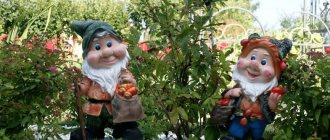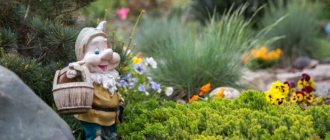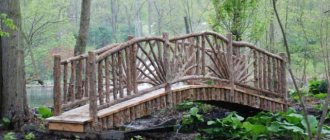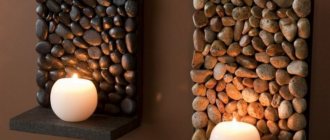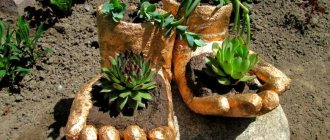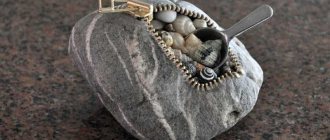A garden at home or at a summer cottage is a free space not only for fruit trees and shrubs, but also for design experiments. On it, owners, together with their children, can create hand-made beauty that will delight babies, preschoolers and even slightly older children. To see this, look at photos of garden figurines made by other craftsmen.
This requires little: imagination, construction and available materials. But some knowledge of style, site layout, and design is also necessary. So that this exquisite plot of paradise greenery does not disturb the overall structure of the garden, does not introduce imbalance or chaos into it, albeit small, does not cause unnecessary associations, but brings joy. Below is our story about this.
Creating compositions
Several small figures will immediately transform the design that is familiar to the eye. Even the presence of one original figurine can make a summer cottage memorable.
Most often, this is just a pleasant addition, however, it can give rise to an idea on how to update the design of the territory by harmoniously placing compositions of figures on it.
When creating an overall picture using elements of figured decor, you can start from an already installed figurine. It is necessary to accurately determine the criteria for selection and placement, thematic and storyline, and the amount of necessary materials.
Background Definition
The bright background of the area for the composition plays no less a role than the figures themselves. If they are separated from each other even visually, change something.
A small sculpture or craft, say, the family of the old woman Tortilla (turtle) will get lost among the foliage. It is better for them to be in an open place, near paths. Place large items near the pond, among the non-spreading conifers.
Remember where your site is less congested - near the fences. Decorate it, and it will become a wonderful backdrop for a nearby composition or a solitary sculpture, for example, snow-white swans (we’ll tell you how to make them below). Any thing should not stand out from the garden landscape and its style.
Scenario for creativity
It’s good when you already have a secret idea on how to transform your garden, vegetable garden, or the area in front of your house. Figurines for the garden and vegetable garden, arranged according to your own scenario, will have a truly “fabulous” look.
You can choose one general direction or individually designate certain areas with your own plot.
Avoid eclecticism
The figures should not be connected chaotically into a composition. A full-length replica of an anaconda hanging on the fence will scare not only your children, but also your neighbors.
Exclusive figurines will decorate any garden, already blooming or just beginning. Below is a selection of interesting stories.
Variety of compositional elements
When one type of material is chosen as a basis, this allows you to combine figures of different themes into a common design style. Decorative figurines made of wood, stone, and ceramics look great. It is easier to use gypsum and plastic in your work.
Small crafts installed at the dacha can represent various “characters”. The presence of other interesting structures brings admiration and joy. A bridge, a hut, a small bench. And although they are not intended for practical use, you never get tired of looking at and admiring them.
Romantic swans
You need two tires with a diameter of up to 80 cm. Mark half the circle, cut out a long neck and an elegant head from its chassis. From the rest of the sides, cut out like leaves, this is an imitation of feathers.
Place two swans, painted with white acrylic, one after the other on a green lawn. It is better and easier to make cuts using a grinder.
Ingredients for boletus mushroom
The following components are needed for manufacturing:
- half a kilo of gypsum material or cement mixture;
- construction PVA;
- varnish paint;
- enamel, for performing work related to coating glass and ceramics;
- pencil;
- compass;
- brushes;
- large needle, knife or woodworking cutters - your choice;
- ordinary cling film;
- empty bottle (plastic) of appropriate shape;
- a cup for casting the base and another for shaping the mushroom cap
- decor - beads, figures, leaves, flowers;
- glue for fixation (waterproof);
- soap, water, sunflower oil.
Choosing a landscape design style (photo examples)
When choosing figures, it is worth remembering the design and following the overall theme, which will be in harmony with the style of the site. If the garden area is decorated in a country style, feel free to place gnomes and figures of domestic animals - roosters and hens, goats, cows, geese, ducks, etc.
The oriental style dictates a limitation in figures, so one large statue of Buddha, a stone lantern, a crane or a dragon will be enough. It can also be almost any creature frozen in meditation. Japanese gardens are designed in the spirit of minimalism, and stones rather than figures should predominate in them.
Provence is similar to a rustic theme, but sculptural elements should not be painted in all the colors of the rainbow; choose white, sand and gray shades. Lavender colors would also be appropriate.
, the high-tech style is the most difficult for the home craftsman. But a couple of concrete balls (cubes, rhombuses, pyramids - other geometric shapes) will successfully emphasize the taste of the owner of the site. Modernism is not very common in Russian regions, but European practice is gradually winning over our owners of private houses. Laconicism, whimsical forms and asymmetry are the main points of this style.
Today there are many fans of the Greek style - to recreate it, sculptures of ancient Greek goddesses, amphoras and fragments of columns are placed on the territory. It is difficult to create such products with your own hands, but it is possible - even a wine bottle can be turned into an amphora.
In English design, garden figurines are practically not used. Lovers of everything British can decorate a flowerbed or lawn with their favorite characters from English fairy tales such as “Alice’s Adventures in Wonderland,” “Harry Potter,” “Winnie the Pooh and All-All-All.”
ECO style does not accept rubber or plastic. Wooden, metal or stone products would be appropriate here. Figurines and garden items with a rustic theme will fit perfectly into the eco-landscape.
Leg
The neck of the bottle is cut off. This is the shape for the leg. The walls are covered with soap and water plus oil. Ratio 2:7:1. The emulsion is applied with a brush. The plaster is partially diluted in accordance with the attached instructions and poured into the mold.
To save money, you can insert a bottle into the solidifying mass and press it down with a press. Then the leg will become hollow. After about forty minutes, the workpiece hardens and is removed using a knife for further processing.
Papier mache
Papier-mâché is considered the most affordable way to create garden decorations. Any scraps of paper are suitable for the base: old newspaper, toilet paper, wallpaper.
The difficulty of execution lies in the fact that drying of each layer is required. Therefore, it may take more than one week to create one character. Such products turn out to be hard, but they are afraid of frost and moisture.
hat
A cup of suitable shape is covered with film (cellophane) as tightly as possible. The next portion is diluted for a cap of the same consistency. It is poured into a cup and remains there until it hardens completely, the same amount of time as a mushroom stem.
Note!
- How to make a hot smoked smokehouse - 75 photos of the best ideas and step-by-step instructions
- Molds for paving slabs - easy instructions on how to make them yourself (80 photo ideas)
Feeder for chickens - ideas, description of construction and features of creating feeders from scrap materials
Wooden decor
Products made from natural materials look organic in any area. You can use growing trees or stumps as a base.
You can make an artificial pond from the remains of a large tree. Old branches, boards and logs can be an excellent material for making decorative wells and huts.
Mushroom installation site
The base for the figurine is also plaster. It is made as follows. The diluted solution is poured into a cup of appropriate size, covered with a film or a special lubricating emulsion.
You can also immerse the “leg” there. You can leave it removable, that is, pre-wrap it in cellophane before immersion. About forty minutes and you can take it out. Ready. Before painting, dry thoroughly for a day or two in a warm place.
Do-it-yourself restoration of garden figures
If there were already figures in the garden, but they fell into disrepair, you can start restoring them.
To repair gypsum elements, you need to stock up on gypsum and cement mortar to mold missing or broken parts.
If stone figures become unusable, you can easily repaint them in other colors and give them new meaning.
Decor
For this, a sketch is created. On the mushroom, a pencil marks the places where the decoration elements will be located. The sketch is given a convexity using a needle (cutter).
Priming the surface will improve the quality of painting. PVA plus water – 1 to 2 – is an excellent solution for a primer. The figurine is painted, decorated and varnished. One mushroom is ready. You can make as many of them as you like.
Before you start creating
A hut on chicken legs
In any work, even creative work, adherence to general rules and adherence to the concept are required. Garden decoration is no exception. Otherwise, you risk creating a tasteless landscape of chaotic objects, the puzzles of which do not fit into a coherent picture.
So, check out these helpful tips before you start:
- Pre-select the places where the figures will be installed. For some of them it will be necessary to prepare the foundation. This should be taken into account so as not to interfere with the growth of garden crops
- Look around your garden and determine what style its design belongs to. It could be a Japanese design or a simple rustic country style. Or maybe there are romantic accents or elements of the high-tech genre?
- It is necessary to clearly understand that cute colored hearts and balloons will not fit into the world of metal structures, and fairy-tale characters will feel strange in the exterior of the Japanese landscape
- Let the size of the figurines be combined with the size of the rest of the garden items. For example, among large trees you can install a large mushroom. And next to low bushes it is better to place small gnomes or lambs
- All designs must be compatible with each other. If you have chosen the theme of children's fairy tales, you should not add iron lizards made of nails and nuts, abstract geometric spheres made of cement, or wooden bicycles with flower pots.
Practice moderation. Sometimes it's so hard to stop, especially once you get the hang of it. However, several funny figures in different corners of the dacha look much more harmonious than a pile of them over the entire area.
Small shaped plastic decorations
One of the most common materials for crafts is ordinary plastic bottles of various sizes. They constantly accumulate, especially in the warm season.
If you apply a little imagination to them and use the services of a website that provides a sufficient number of interesting options, then you can successfully create a “small miracle” in your dacha space.
Plastic figurines for the garden are an excellent theme for decorating the landscape. They are light, not susceptible to damage by water and are in perfect harmony with the atmosphere of a country house mood. Bottles with a small volume, for example, can serve as a basis for bright working bees.
If you give them a striped yellow and black color and hang them on tree branches, the breeze will create a mesmerizing illusion of flight. For the antennae you will need a wire threaded through the cap.
An exotic “palm tree”, one or several, will turn a small space into a kind of island. The main material is plastic bottles. They are cut and inserted one into the other. Now the barrel is ready. Leaves are attached to the top. Green blanks from larger bottles. Beautifully place sand and stones under improvised “palm trees”. This will add African flavor.
Scales in the wind
The wind can be a “composer” if you create an instrument for it. Find plastic flower pots at home, larger ones in the center, smaller ones around.
Paint it with bright colors, and wrap at least one with food foil - the sun will shimmer on it, and the thief birds of your harvest are afraid of this. Hang it all on a hook at a height of up to 2 meters. The wind itself will create music, shaking the pots and rattling them.
Nice price for prompt delivery of water to your home in Kharkov from the VodSnab online store- Favorable price for apartment renovation from a reliable Odessa company Stroy House
How to insulate a balcony?
Photos of figurines for the garden
Care
Decorations installed on the site require some attention. Store-bought figurines for the garden, or those made by yourself, lose their attractiveness when exposed to the sun, rain, frost and wind. Accumulated dust on papier-mâché products and plaster figurines must be wiped regularly with a soft cloth.
Products made from polyurethane foam and plastic can be refreshed using a water spray. Concrete and wooden figures can be easily washed with a hose.
Regularly, maybe even several times a season, garden decorations need to be tinted. Thus, the decorations of the site will delight their owners for a long time and enhance the landscape interior.
Types of forms
The production of garden figures without the use of molds is impossible. It is they who help create the basis, which can then be modified and decorated, brought to a commercial appearance. Today on sale you can find molds made of different materials. Each variety has its own advantages and disadvantages.
Plaster molds
These are the most affordable molds. Their cost price is equal to the cost of the material spent. You can buy ready-made samples in specialized stores, or you can make them yourself. For this you will need formwork. It can be made using thick cardboard. The joints are secured with tape. If there are remnants of chipboard and furniture confirmats in the house, they will also make good formwork.
Before pouring plaster, the figurine is generously coated with liquid soap. Then you need to let it dry. Using a similar procedure, it is possible to create a protective separating layer on the base, which will then allow the garden figurine to be removed from the frozen form. The base is placed inside the formwork, and a liquid solution prepared from gypsum powder and water is poured onto it. Its consistency should be like thin sour cream.
Formwork for pouring gypsum, made from remnants of chipboard Source restaurarconservar.com
Afterwards, you need to wait for the solution to completely harden. Then the mold must be carefully cut in half with a thin hacksaw and the product removed. Experts recommend immediately coating the resulting relief inside the workpiece with a thin layer of epoxy glue. And let it all dry thoroughly again. The mold is ready to use. In order to make a copy, you need to generously coat the inside of the mold with liquid soap, let it dry well, after which you can pour liquid plaster inside.
Attention! Making garden figures using plaster molds is a very labor-intensive process. The molds themselves weigh a lot, after pouring they become even heavier; you will have to put a lot of effort into removing the blank from the mold. If moved carelessly, the product can break, and then all the work goes down the drain.
See also: Catalog of companies that specialize in landscape design of sites.
Polymer forms
They are made of fiberglass. The finished samples weigh very little, but still the polymer is also a brittle material. Practice shows that it can withstand a limited number of pours. Many manufacturers purchase polymer molds to make plaster copies. This helps optimize costs and significantly simplify the process of making molds for filling garden figures yourself.
Polymer molds for filling garden figures Source pabrashu.info
Metal molds
They are used extremely rarely today. And all because working with such basics is very time-consuming and effort-consuming. The result is a product with a lot of sagging remaining on its surface. They have to be additionally cleaned, which increases the production time of one product.
Silicone molds
When silicone appeared, many problems in the production of garden figures were solved by themselves. Molds with a metal base, inside of which there are two layers of soft, dense silicone, have appeared on sale. The two halves of the mold are connected to each other using bolts. There is a place at the base for pouring liquid composition.
The mold has one design feature: one part overlaps the second part. This helps to end up with a figure that does not have a swell in the center. After pouring, the mold does not need to be constantly shaken, allowing the liquid gypsum or polymer to be evenly redistributed. The properties of silicone are such that you can do without this procedure. No cavities are formed on the surface of the finished product; there are no voids inside. This means that the figure will last much longer.
Silicone mold for making garden decor Source moysadiogorod.ru
Introduction
Cute touches for the garden
For many people, a garden is not just a useful area for growing berries and vegetables. This is a place where the soul can rest after stressful workdays, the bustle of the city and everyday worries. Here you can recharge your batteries, relax properly, and feel relaxed.
A place that was created with love will definitely respond to you with a warm and peaceful atmosphere. Friends and relatives will be happy to come here to sit by the fire in the evening and have a barbecue in the open air. And even weeding the beds in the morning won’t scare anyone.
Of course, ready-made statues can be purchased at garden stores. But it’s much more fun to create your own, unique designs, showing creativity and artistic taste. Moreover, the process brings all participants together very closely; all family members, even the smallest ones, can be involved in it.
Begonia - care and propagation at home (120 Photos & Videos) + Reviews
Concrete composition
For modeling, you need a plastic concrete mixture that adheres well to the metal of the frame and to the already laid layers.
The main additives are slaked lime and clay. They turn building concrete into sculptural concrete, which does not spread, but retains the shape that we give it.
It is better to take kaolin clay. Fireclay clay or bentonite will give a grayish tint, which may be undesirable in decorative concrete.
As plasticizers that reduce the need for concrete in water, we use CMC glue and (or) PVA emulsion. They are also good because CMC increases the viscosity of concrete, and PVA increases adhesion (“stickiness”). You can also add special plasticizers for concrete.
We will also add polypropylene fiber to the concrete for the first layers. It will improve the adhesion of layers, reduce the risk of cracks to almost zero, and increase frost resistance.
Adding a gypsum mixture for plaster will speed up setting and make modeling easier.
Its disadvantage is that it reduces the resistance of concrete to atmospheric influences, so it must be used with caution, without exceeding the dosage
One of the composition options for sculptural concrete:
| Item no. | Name | Quantity | Notes | |
| In volume fractions | In kg per m³ of mixture | |||
| 1 | Cement PC M500 | 12 | 260 | For decorative concrete, cement PB500, quartz sand, marble or other decorative chips |
| 2 | Washed sand | 22 | 520 | |
| 3 | Crushed stone fraction 3-5 mm | 39 | 990 | |
| 4 | Water | 8 | 110 | |
| 5 | Slaked lime | 5 | 70 | |
| 6 | Clay | 5 | 120 | for decorative concrete kaolin |
| 7 | Polypropylene fiber 6-10 mm | 6 | 25 | For lower layers |
| 8 | Gypsum plaster (putty) mixture | 2 | 20 | Not for use with quick-setting cement |
| 9 | KMC | 0,5 | 3 | |
| 10 | PVA | 0,5 | 9 | |
| 11 | Color pigments | Until you get the desired shade | ||
| Total: | 100 | 2127 |
Mix CMC and PVA in water in advance. Mix gypsum, fiber and cement in dry form. We add lime and clay along with sand and crushed stone.
The consistency should be something between soft butter and thick sour cream.
Plaster creations
Gnomes guard the country Christmas tree
Gypsum is a very convenient material; it is strong, durable and water resistant. Paints fit perfectly on it. Working with such raw materials is a pleasure.
So, the first thing you need to do is go to a hardware store and buy the necessary form for pouring. Silicone ones are best. Let's look at step-by-step instructions using a plaster gnome as an example, but you are free to sculpt any other character.
- If you plan to sculpt a tall statue, more than 1 m in height, you will need to make a metal frame. It’s better not to bother and create a short figure up to 0.7 m. This way it will become lighter in weight, it can be lifted, rearranged, and put away in the garage for the winter
- Following the instructions on the plaster packaging exactly, dilute the composition with water. The mass is mixed well until it has a homogeneous mushy consistency. To make the material elastic, PVA glue is poured into it. Approximately 10 g per 1 kg of dry gypsum
- Now fill half the volume of the mold with the prepared solution and let it set. Then fill the container to the top. Lightly tap the sides to release the air.
- The form is removed only after the gnome has completely dried. Give him at least two days
- The painting stage begins. First, prime the entire surface. After this, you can apply colored paints, and after they dry, varnish for better color preservation.
Garden cranberries: planting and care, recommendations for growing from seeds in a summer cottage, beneficial properties, cooking uses | +Reviews
Generalization on the topic
The business described is a wide field for activity. It can bring good profits if it is constantly developed. This must be done by involving professional artists and sculptors. The cost of exclusive works is much higher than products made according to standard sketches. Garden decorations that glow in the dark can interest buyers. And if you open a multidisciplinary company and add to the staff employees involved in landscape design, providing services for the care of the created landscaping, profits will only increase.
Ratings 0
Choosing a location
When purchasing or making original figurines, you must first select a place to place them. They must fit as harmoniously as possible into the overall style of the building, otherwise the expected effect will be reduced to zero.
Where are these figures installed? It depends on the preferences of the inhabitants of the house. Some install them in flower beds, around ponds, in wooden gazebos, sometimes they decorate stairs and verandas, garden trees and bushes.


